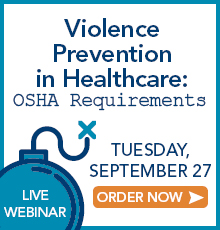
Hospital Consult - August 2016
|
Free Monthly News from Award Winning Publisher of: |
||||
|
Hospital Access Manage- ment |
Hospital Case Manage- ment |
Hospital Employee Health | Hospital Infection Control |
Hospital Peer Review |
|
Health- care Risk Manage- ment |
Case Manage- ment Advisor |
IRB Advisor |
Medical Ethics Advisor |
Same- Day Surgery |
Controversy Surrounds Release of New CMS Hospital Star Ratings
WASHINGTON, DC – Despite strong opposition from the hospital industry, the Centers for Medicare & Medicaid Services (CMS) recently released its new star ratings for hospitals on its Hospital Compare website.
The new Overall Hospital Quality Star Rating summarizes data from existing quality measures publicly reported on Hospital Compare into a single star rating for each hospital, which CMS touts as an upgrade that makes it easier for consumers to compare hospitals and interpret complex quality information. The agency said the overall rating supplements the more specific star ratings currently posted for hospitals on patient experience data derived from the Hospital Consumer Assessment of Healthcare Providers and Systems (HCAHPS) survey. The patient experience of care hospital star ratings were first publicly reported in April 2015.
While CMS maintains that the new ratings “help millions of patients and their families learn about the quality of hospitals, compare facilities in their area side-by-side, and ask important questions about care quality when visiting a hospital or other healthcare provider,” the American Hospital Association strongly disagrees.
“The new CMS star ratings program is confusing for patients and families trying to choose the best hospital to meet their healthcare needs,” responded AHA President and CEO Rick Pollack. “Healthcare consumers making critical decisions about their care cannot be expected to rely on a rating system that raises far more questions than answers. And it adds yet another to a long list of conflicting rating and ranking systems … We want to work with CMS and the Congress to fix the hospital star ratings so that it is helpful and useful to both patients and the hospitals that treat them.”
Earlier this month, the AHA and other industry groups urged CMS to share additional information with the healthcare industry and the public about how accurately the overall hospital quality star ratings portray hospital performance. They also asked the federal government to either work with hospitals to validate the methodology or continue to withhold publication of the ratings.
The AHA said its concerns about the flawed data are based on an analysis by an independent expert.
Release of the ratings were delayed in April after a bipartisan majority of both houses of Congress urged that action, asking CMS to work with the hospital field to ensure the ratings are fair and reliable.
CMS maintains in a press release that it met all of those objections, noting, “Today’s update comes after substantive discussions with hospitals and other stakeholders to review the Overall Hospital Quality Star Rating’s methodology.”
Kate Goodrich, MD, MHS, Director of Center for Clinical Standards and Quality, said in a blog that, during the delay, the agency conducted significant outreach and education to hospitals to understand their concerns and directly answer questions.
Star ratings are based on 64 individual measures, including death, infection rates, and patient reviews, and CMS said specialized and "cutting-edge care," such as the latest cancer treatments, were not reflected in the ratings.
The rating system has been criticized for penalizing hospitals that treat patients with low socioeconomic status or multiple complex chronic conditions. The result is that some of the most highly rated hospitals performing complex procedures and treating the sickest patients often are ranked low on the five-star scale.
In fact, just 102 hospitals received the top rating of five stars, and that list didn’t include some of the institutions receiving highest ratings elsewhere, such as Massachusetts General Hospital in Boston, which was at the top of U.S. News & World Report’s Honor Roll of Best Hospitals.

Risk Model Helps Predict, Mitigate Pneumonia Risk after CABG Surgery
ANN ARBOR, MI – What if a hospital knew beforehand which open-heart surgery patients were most likely to develop pneumonia as a post-surgery complication?
That is possible with a new risk model designed to guide clinical decision-making and physician-patient conversations about regimens to pursue before the procedure to help avoid pneumonia, according to a report in Annals of Thoracic Surgery.
Pneumonia occurs in 3.3% of patients and often leads to longer hospital stays and lower odds of survival, according to the University of Michigan-led research. For the study, the researchers analyzed data from 16,084 patients who had coronary artery bypass graft (CABG) surgery at 33 Michigan hospitals.
The result is a list of 17 patient characteristics, including age, race, smoking habits, and white blood cell count, among others, found to be associated with developing pneumonia after cardiac surgery.
"This work reflects an evolution of our understanding of postoperative infections," explained senior study author Donald Likosky, PhD. He said in a University of Michigan Health System press release that the model can help hospitals “go a long way to preserve resources and help patients recover from one of the country's most common cardiac procedures."
According to the study, the strongest indicators for development of pneumonia included the following:
- admission for heart surgery via the emergency room,
- a history of lung problems,
- a long hospital stay before surgery, and
- low ejection fraction.
Smoking is another well-recognized risk factor for postoperative pneumonia, and study authors said that quitting smoking, even just a month before surgery, can help prevent pneumonia development.
If another complication — leukocytosis — is present, researchers suggested that surgery be delayed, however. "Patients presenting with an elevated white blood cell count before their operation may be mounting an immune response against a pathogen or other challenge, and CABG significantly increases their odds of postoperative pneumonia," pointed out co-author Gaetano Paone, MD, MHSA, a cardiac surgeon at the Henry Ford Health System.
“We identified 17 readily obtainable preoperative variables associated with postoperative pneumonia,” study authors concluded. “This model may be used to provide individualized risk estimation and to identify opportunities to reduce a patient’s preoperative risk of pneumonia through prehabilitation.”

HAI Rates Reduced By Transporting ICU Patients Less Often
SUMMIT, NJ --Immobilized, ventilator-dependent ICU patients are at the highest risk of hospital-acquired infections (HAIs). A New Jersey health center was able to lower the infection rate by doing less, not more.
An article published in the journal Neurocritical Care reports how fewer transports and more judicious use of catheters reduced the infection rate in those patients.
“Despite broad implementation of relevant bundles, HAI incidence in our neuro ICU remained high, particularly catheter-associated urinary tract infections (CAUTIs) and ventilator-associated events (VAEs),” reported researchers from Atlantic Health System. “We reviewed the administrative data and nosocomial infection markers (NIMs) for all neurology and cranial neurosurgery patients admitted to our neuro ICU between January 2011 and May 2014, identified and implemented interventions, and measured effects using National Healthcare Safety Network (NHSN)-defined CAUTIs and VAEs.”
Among the interventions were the following:
- reviewing Foley catheter use, including indications and alternatives, and instituting daily rounds, continuously questioning the ongoing need for a catheter,
- re-educating neuro ICU personnel in insertion and maintenance technique, introducing a new kit that simplified and standardized sterile insertion, and
- placing a mobile CT in the neuro ICU, since patients required repeated transports for brain imaging and since researchers found correlations between frequencies of these transports, and both respiratory and urinary NIMS.
Results indicate that VAEs decreased 48%, Foley use decreased 46%, CAUTIs decreased from 11/1000 catheter days to 6.2. At the same time, the overall complication rate decreased 55%, ICU length of stay dropped by 1.5 days, and risk-adjusted mortality declined by 11%.
“Combining a multidisciplinary approach with rigorous analysis of objective data, we decreased total HAIs by 53% over 18 months,” study authors wrote. “Key drivers were decreased urinary catheter use and decreased patient transport from the ICU for imaging.”
“Through a rigorous analysis, we were able to pinpoint causes and take actions that, together, had a very significant impact on preventing ventilator and urinary catheter-related infections,” lead investigator John J. Halperin, MD, chair of the department of neurosciences at Overlook Medical Center, said in an Atlantic Health System press release. “Better training and limiting the use of catheters was important in this effort. But the real surprise was that transporting patients for brain imagining was a major source of the problem, and by introducing a mobile CT scanner we could substantially reduce infections.”

Hospitals Play Role in Lower Breastfeeding Rates Among Some Groups
EVANSTON, IL – Hospital practices appear to play a role in the significant racial and ethnic disparities in breastfeeding outcomes, according to a recent study published online by the journal Pediatrics.
"We found that higher rates of poverty and lower levels of education helped explain breastfeeding gaps between black and white women, especially in determining whether mothers started breastfeeding in the first place," said co-author Sharon Landesman Ramey, PhD, a professor and distinguished research scholar at the Virginia Tech Carilion Research Institute in Roanoke, VA. "But those factors weren't the only ones responsible for mediating these relationships."
Researchers reported they were surprised by a broad difference in mothers' initial decision to breastfeed, finding that black mothers were nine times more likely to be given formula for their babies than white mothers in the hospital.
"Our results suggest that hospitals and policy makers should limit in-hospital formula introduction and consider family history and demographics to reduce racial and ethnic breastfeeding disparities," emphasized co-investigator Madeleine Shalowitz, MD, MBA, a director at the NorthShore University Health System Research Institute in Evanston.
"Hospitals and policy makers should consider non-demographic factors to help reduce racial and ethnic breastfeeding disparities," Ramey added. "Change is possible, and it's necessary."
The American Academy of Pediatrics recommends children should be exclusively breastfed for the first six months of life, with continued breastfeeding and complementary foods until the child's first birthday, at a minimum. Despite the recommendation, about half of children in the United States are weaned from breastfeeding by the time they are six months old, according to background information in the report.
To help determine why, researchers analyzed data from the Community and Child Health Network study, assessing breastfeeding initiation, postnatal intent to breastfeed, and breastfeeding duration postpartum among 1,636 mothers in Los Angeles, Baltimore, Washington, DC, and Lake County, IL. The mother's immediate intent regarding breastfeeding was recorded with follow-up at one month and again at six months after birth.
Results indicate that Spanish-speaking Hispanic mothers were most likely to initiate (91%), intend (92%), and maintain (mean duration, 17.1 weeks) breastfeeding, followed by English-speaking Hispanic mothers (initiation 90%, intent 88%; mean duration, 10.4 weeks) and white mothers (initiation 78%, intent 77%; mean duration, 16.5 weeks). Least likely to initiate were black mothers (61%), who also showed lower rates for intend (57%), and maintain breastfeeding (mean duration, 6.4 weeks).

|
UPCOMING HOSPITAL WEBINARS Live + On Demand Access |
||
|---|---|---|
 |
Record of Care: Ensure Your Hospital's Compliance | Sign Up → |
 |
The Latest and Greatest CMS Nursing CoPs | Sign Up → |
 |
CMS Medical Records: What You Need to Know | Sign Up → |
 |
Give Falls the Slip: CMS, DNV & TJC Hospital CoPs & Standards | Sign Up → |
 |
EMTALA Update 2016: Deficiencies, Problematic Standards and Practitioner Liability | Sign Up → |
 |
Infant and Pediatric Abductions: Prevent the Unimaginable Tragedy | Sign Up → |
 |
Safe Injection Practices and IV Push Guidelines: Compliance with CDC and CMS Standards | Sign Up → |
 |
Restraint and Seclusion: CMS, DNV, & TJC Guidelines and Standards | Sign Up → |
 |
Discharge Planning: CMS Worksheet & Standards | Sign Up → |

